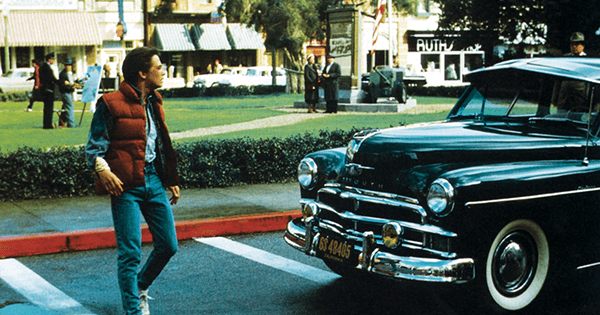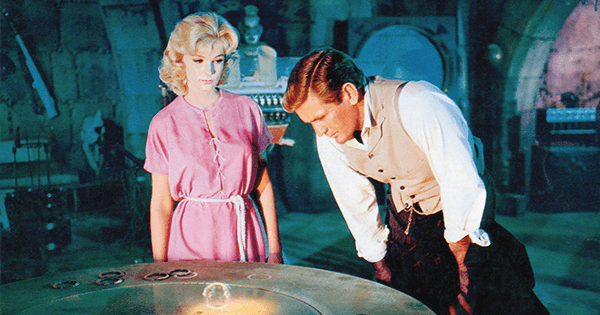
Time Travel: A History by James Gleick; Pantheon, 352 pp., $26.95
Now: The Physics of Time by Richard A. Muller; Norton, 368 pp., $27.95
Earlier this year, I was approached by a woman desperate to send a message back in time. She had made some awful mistake and wanted to know if there was any way at all to undo it. I tried to break the news gently. Even if we could build a time machine, we couldn’t change the past—by definition. And thank goodness. Prevent Hitler’s birth, and you’d clear the way for an even more horrifyingly effective Nazi leader; uninvent nuclear weapons, and you’d cripple space travel, dooming humanity to stasis and extinction. Let’s focus on changing the future. That’s hard enough.
Regret, writes James Gleick in his latest book, Time Travel, is the animating force of time-travel stories and the emotion their protagonists must ultimately learn to live with, because the alternative is invariably worse. Gleick surveys a huge variety of these tales. Their themes (personal identity, free will, alternative history) always manage to seem profound, and their plot devices (nonlinear narratives, causal puzzles, anachronistic farces) never go stale. Their conventions are so familiar to modern audiences that it’s easy to forget how young the genre is. Some important precursors notwithstanding, the time machine didn’t exist as a category until H. G. Wells’s 1895 book by that name.
Wells captured a cultural moment. In the tradition of Ohio State University historian Stephen Kern’s The Culture of Time and Space: 1880–1918, Gleick describes how time was a preoccupation of the fin de siècle. Industrialization and urbanization had created a narrative of progress. You wouldn’t grow up doing what your parents did. Trains and telegraphs created a need for standardized time; scientific managers wrung every second out of a worker’s day; psychoanalysts and modernist authors delved into the vagaries of memory and anticipation; biologists and geologists beheld a creation that did not cease on the sixth day.
Not least, Einstein threw out the classical view of absolute time. Physics is routinely invoked in time-travel stories, whose characters never seem to have heard of time machines and have to be sat down, lectured on the fourth dimension, and warned not to have sex with people who look curiously like them. And yet physicists have followed as often as they’ve led. Time-travel authors recognized causal paradoxes—killing your grandfather and all that—long before the supposed experts did. “The rules of time travel have been written not by scientists but by storytellers,” Gleick writes. Unfortunately, Gleick is weaker on the science than on the stories, relying on spotty secondary reading rather than the exhaustive interviewing that distinguished his previous books.

Physicists face an interesting metaparadox: storytellers have convinced them that time travel can’t be possible, but their current theories tell them it should be. According to Einstein’s theory of relativity, “now” is relative, like “here.” What is happening to you right now might lie in my future. You consider the events you witness to be very real, so I should consider them to be real, too. My future must already be out there; I just haven’t come to it yet. By this logic, the entire history of the universe is laid out in a “block universe”—a timescape through which we travel in much the same way as we traverse a landscape. The timescape can bend back on itself, creating time loops, with all their potential for paradox. Other theories, too, hint at time travel. Quantum mechanics, for example, can be interpreted as saying that particles are sensitive to events in their future.
Despite these promising intimations, every specific design for a time portal turns out to have a fatal flaw. Oddly, the flaw—be it the need for exotic forms of energy or a tendency to blow up—differs from case to case, and it’s not always clear what the flaw has to do with the usual paradoxes. This suggests that there is some deep, universal principle that rules out time travel and that awaits discovery in a grand unified theory of physics. Maybe the physicists will then have something to teach the storytellers.
One idea making the rounds is that time isn’t a fundamental ingredient of reality but derives from some deeper level of physics, and that the pace of events is not a given but must be actively constructed. Here, too, physicists are playing catch-up with the broader culture. In his book, Kern suggested that the greatest upheaval in our conception of time a century ago was the notion of the present moment. The Titanic’s sinking, experienced in real time by people within wireless range, made it a thing to ask what was happening somewhere else “right now.” Today, Gleick muses, we are so consumed with current events that the past and future barely register. Social media “timelines” are governed by algorithms, and computer users flit among multiple asynchronous conversations. “What remains is a kind of atemporality, a present tense in which temporal order feels as arbitrary as alphabetical order,” he writes. Time was supposed to keep everything from happening all at once. In that respect, each of us now lives in a time of our own making.
Not all physicists accept the block universe, let alone a reality that is fundamentally atemporal. The latest dissenter is Berkeley physicist Richard Muller. In his new book, Now, he ventures that his colleagues should take our folk conception of time more seriously than they have. We feel that time passes, the past is fixed, the future is open, and the present moment is all that is real. Muller calls on scientists to explain this intuition, not explain it away. He would replace the static block universe with what physicists and philosophers call a growing or evolving block universe, in which the future is indeed open and the timescape unfurls moment by moment. Quantum indeterminism would naturally fit into such a scheme: the outcome of a particle process is genuinely open until the instant it happens. You can forget about time machines: the future can’t affect the past if it doesn’t exist.
The standard block universe is not the only widely held concept that Muller seeks to take down. Most physicists attribute the arrow of time—the difference between past and future—to the tendency of entropy (loosely defined as the degree of disorder in a system) to increase. And for entropy to have increased, it must have started out with a low value, presumably because of the highly ordered conditions of the universe’s birth. We are sliding down a cosmic slope. Muller considers that explanation not just wrong but not even wrong, a statement that cannot be falsified. Its advocates brush off every apparent counterexample, such as primeval epochs in which entropy remained constant. So how could the theory ever be tested?
Being willing to rethink conventional wisdom: commendable. Backing up your assertions with arguments: priceless. Muller’s book falls down on that. It addresses none of the obvious objections to its assertions. “Every second, we add a new second of time … [t]ime is being created,” Muller writes. He even suggests that the rate of its creation is accelerating. Are these statements logically coherent? Creation occurs within time, so how would you define the creation of time? Furthermore, how could an objective present moment be squared with relativity theory, according to which different observers can have different but equally valid notions of “now”? Other theorists with similar views, such as George Ellis and Lee Smolin, acknowledge the tension with relativity theory and argue that the expansion of the universe favors some observers over others. Muller gives the issue short shrift and fails to cite any of the extensive literature on the topic.
His thoughts on the arrow of time are equally underdeveloped. He does nothing to solve the key puzzle, which isn’t that time has an arrow, but that it doesn’t have one. Individual particles behave in a time-symmetric way, indicating that time itself lacks a direction. The difference between past and future must be a property not of time but of how matter is arranged within time, and it must be a statistical effect arising only for large numbers of particles. The law of entropy increase is just such a statistical effect. Muller’s counter-examples are unconvincing—for instance, the early universe didn’t have constant entropy once you consider gravity—and he provides no real alternative. The growing block model is of no help; to the contrary, it presupposes a solution. Without an arrow, a growing block is no different from a shrinking one, as philosopher Barry Dainton has argued. Likewise, quantum indeterminism can single out a direction in time only if the universe began in a very special quantum state.
Time is one of the central features of human experience, yet it remains deeply mysterious, and it demands the full range of human ingenuity to be understood. As both Gleick and Muller emphasize, time is too important to be left to the physicists. And if you’re looking for comfort, physicists are definitely the wrong people to ask. We play by the world’s rules, rather than the other way around, and we need to construct meaning in the world by taking it as it is.

